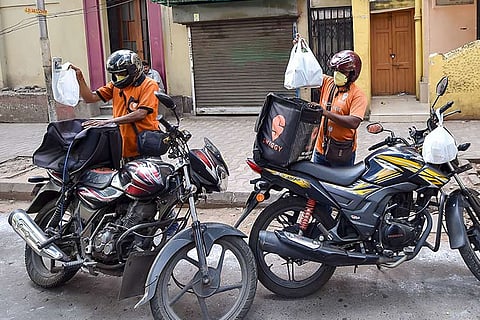

Many of you might be quarantined at home and practising social distancing carefully as directed by the government to contain the spread of coronavirus. However, it is inevitable that you come into contact with at least groceries, food items and other essentials from the outside.
If you have chosen to have them delivered to your doorstep, these are some steps to reduce the risk when you go about handling these items. Even if you prefer to step out and buy groceries or food, the tips regarding handling the packaging are relevant.
Social distancing between the delivery person and you
Practising social distancing with the delivery person is important to ensure that neither person ends up transmitting the coronavirus to the other. You can request a contactless delivery if possible, so that the delivery person leaves the ordered items outside your doorstep and informs you over the phone.
If the payment involves cash, remember to wash your hands before and after handling the cash. Even while choosing digital payment methods or contactless deliveries, transferring your tip to the delivery worker can be worked out over the phone.
If the items are being delivered or collected in reusable grocery bags, wash them after every delivery.
Disposing packaging material
Although the World Health Organisation (WHO) says it is not certain for how long the novel coronavirus can survive on surfaces, it is believed to behave like other coronaviruses. Studies seem to suggest that coronaviruses can persist on surfaces for a few hours or up to several days, depending on the type of surface, and the temperature and humidity of the environment.
This means it is possible for the virus to be present on the plastic or cardboard packaging in which your food arrives, if an infected person has touched it. While the disease is believed to be transmitted mainly through person-to-person contact, as a precaution, all the packaging material must be disposed carefully. Wash your hands after disposing them.
Remove any disposable cardboard or plastic packaging and set it aside with the rest of your dry waste. Leave the dry waste in a bag where the civic worker can collect it, again without physical contact.
Disinfecting containers
While removing disposable packages, if possible, directly transfer the food into clean containers without allowing it to touch your hands or any other surface. Or, wash your hands after handling the packaging material before transferring the items into containers.
Clean any plastic or metal containers, boxes or cans which cannot be disposed of, with a disinfectant or with soap and water. Avoid touching your mouth, eyes or nose right before touching any food or container.
Food consumption
There is no evidence suggesting that coronavirus is food-borne. But fruits and vegetables which are consumed without cooking must be washed with water as usual, in case anyone has sneezed or coughed on them.
Wash your hands with soap before and after handling fruits and vegetables. Even in the case of bananas and other foods, wash your hands after touching the peel.
Cooked food is more likely to be safe, as cooking temperature is believed to be enough to get rid of the virus.
Do not share food in the same delivery container or the same cutlery with anyone else in the house.